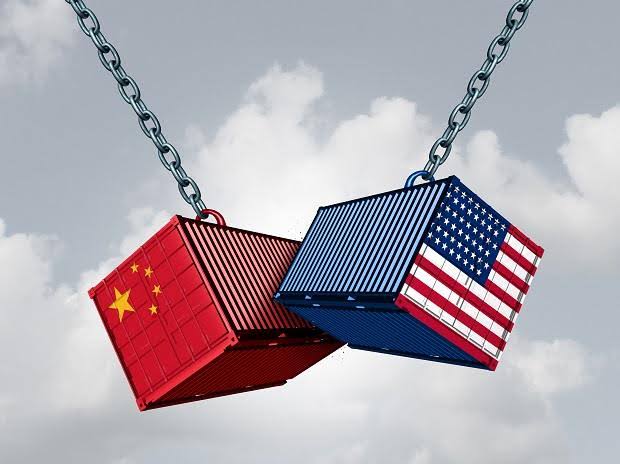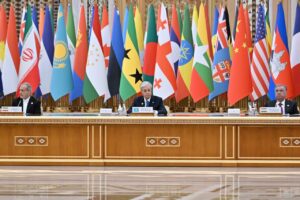Tariffs Backfire: Why the U.S. Trade War Hurts Everyone

In April 2025, the Chinese government released a white paper titled “China’s Position on Some Issues Concerning China-U.S. Economic and Trade Relations.” While such state-issued documents are often dismissed as diplomatic posturing, this one stands out — not for its rhetoric, but for the economic clarity it offers. Beneath the diplomatic language lies a compelling truth: the ongoing trade war driven by the United States has failed to deliver strategic gains and instead has inflicted economic harm on all involved — especially on American households and industries.
Interdependence
For years, Washington has framed U.S.-China economic ties as a competitive struggle — a narrative where China supposedly exploits trade to undermine American industry. But the data tells a different story.
China’s top five exports to the United States — electrical machinery such as smart phones, PCs, and communications ware, mechanical appliances, furniture, toys, and plastic goods — make up 57.2% of total exports. In return, the U.S. supplies China with fossil fuels, precision machinery, electrical components, optical instruments, and agricultural commodities like soybean seeds — accounting for 52.8% of total Chinese imports from the U.S.
In the services sector, too, the relationship has blossomed. U.S. companies generated an estimated $490.5 billion in revenue in China in 2022 — a level of access and opportunity few other countries offer American business.
If you examine the data the old narrative that China merely exports cheap goods while the U.S. supplies high-tech products is outdated and no longer reflects the true nature of their economic relationship. In fact, China has become a major player in global supply chains for technology, exporting significant amounts of electronics and machinery that are increasingly sophisticated, such as semiconductors and telecommunications equipment.
Meanwhile, U.S. exports to China have diversified beyond traditional sectors, now encompassing services, such as finance, software, and consulting, alongside including aerospace and medical equipment. This shift indicates a much more interdependent relationship, where both nations are integral to each other’s growth and global competitiveness.
Tariffs: A Costly Miscalculation
Since 2018, the U.S. has slapped tariffs on over $500 billion worth of Chinese goods. These measures were sold to the American public as tools to protect jobs and revive manufacturing. But after nearly seven years, the results speak for themselves — and they’re far from encouraging.
First, tariffs have acted as a regressive tax on American consumers. Multiple studies have shown that the majority of the tariff costs were absorbed by U.S. importers and passed along to shoppers in the form of higher prices. Inflation in tariff-targeted goods has outpaced general inflation, disproportionately affecting low- and middle-income families. In effect, American households are paying for Washington’s economic missteps.
Second, retaliatory tariffs from China have hit U.S. exporters where it hurts. In response to the trade war, China diversified its sourcing, turning to Brazil, Argentina, and Southeast Asia for soybeans, liquefied natural gas, and other key commodities. American farmers and energy producers — once major suppliers to China — have been sidelined, losing market share that won’t be easily regained.
Third, tariffs have failed to correct the trade imbalance. The U.S. trade deficit with China persists, not due to manipulation, but because of macroeconomic fundamentals like high American consumption, low savings rates, and the global role of the U.S. dollar. China’s current account surplus — a key indicator of global imbalances — has declined from 9.9% of GDP in 2007 to just 2.2% in 2024. The problem is systemic, not bilateral.
The consequences of the trade war extend beyond bilateral losses. Global supply chains — already strained by pandemic-era disruptions — have become more volatile as the U.S. injects geopolitical uncertainty into trade. Businesses are rethinking sourcing, delaying investment, and passing on costs. Countries caught in the middle face price swings and decreased demand.
Worse, this tariff-first approach undermines the global trading system. Talk of revoking China’s Permanent Normal Trade Relations (PNTR) status violates WTO norms and sends a troubling message: the world’s largest economy is willing to sidestep rules when convenient. The result will be fragmentation, inefficiency, and a return to economic nationalism — with long-term damage to global growth.
Rethinking Strategy: Invest, Don’t Isolate
Instead of weaponizing tariffs, the United States should focus on strengthening its own economic fundamentals. That means investing in advanced manufacturing, STEM education, infrastructure, and innovation ecosystems. Building domestic competitiveness requires more than blaming trading partners — it demands strategy, vision, and patience.
Calls for decoupling from China are not just unrealistic — they’re economically dangerous. U.S. and Chinese industries are embedded in complex value chains. Decoupling would not re-shore manufacturing; it would reroute it through costlier, less efficient channels — increasing prices for American businesses and consumers while eroding global competitiveness.
If Washington is serious about economic leadership, it must abandon the illusion that trade is a battlefield. In a globalized world, the cost of conflict is shared — and so is the benefit of cooperation. The trade war is not just a strategic error. It’s an economic one. And the longer it drags on, the higher the price we all pay.
If there’s one takeaway from China’s recent white paper, it is this: not every disagreement requires a weapon; some require a calculator.


